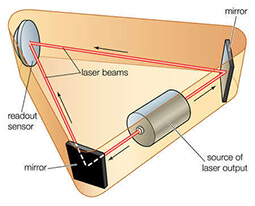Ring Laser Gyroscopes (RLG) and Fiber Optic Gyroscopes (FOG) are both types of optical gyroscopes that make use of the Sagnac effect to measure rotation. Here are the main differences between the two:
-
Technology and Design:
- Ring Laser Gyro (RLG): RLGs use a laser that propagates in a closed-loop resonant cavity formed by mirrors. The device measures the difference in the frequency of the laser beams traveling in opposite directions around the loop.
- Fiber Optic Gyro (FOG): FOGs use an optical fiber coil through which light travels in both clockwise and counterclockwise directions. The device measures the phase shift between the beams caused by rotation.
-
Measurement Principle:
- RLG: Measures the difference in frequency (Doppler shift) between lasers circulating in opposite directions within the rigid cavity.
- FOG: Measures the phase difference (interference) of light traveling through long fiber loops in opposite directions.
-
Sensitivity and Accuracy:
- RLG: Typically offers very high accuracy and precision because of the high coherence and stability of laser beams within the resonant cavity.
- FOG: Also provides high accuracy, but can be made more flexible and scalable by increasing the length of the optical fiber used.
-
Size and Weight:
- RLG: Generally more compact due to the rigid cavity but can be bulky depending on the design and intended application.
- FOG: Can be lighter and more flexible, allowing for ease of integration into various systems. The optical fiber can be coiled to achieve the desired sensitivity.
-
Cost:
- RLG: Usually more expensive because of the precise manufacturing and alignment of the mirrors in the laser cavity.
- FOG: Typically less expensive and can benefit from economies of scale due to the simpler design and mass production of optical fibers.
-
Environmental Sensitivity:
- RLG: May require temperature control and can be more sensitive to mechanical vibrations due to the rigid structure of the cavity.
- FOG: More robust and less sensitive to mechanical stresses and temperature variations, making them suitable for harsh environments.
-
Applications:
- RLG: Widely used in high-end applications requiring extreme precision, such as aerospace, military navigation systems, and scientific research.
- FOG: Used in a variety of applications, including automotive, industrial robotics, and commercial aircraft, where compact size and robustness are advantageous.

In summary, while both RLGs and FOGs are effective for precise rotation measurement, they differ in their operation principles, design, cost, and typical applications. RLGs are known for their high precision, whereas FOGs offer versatility and robustness.
